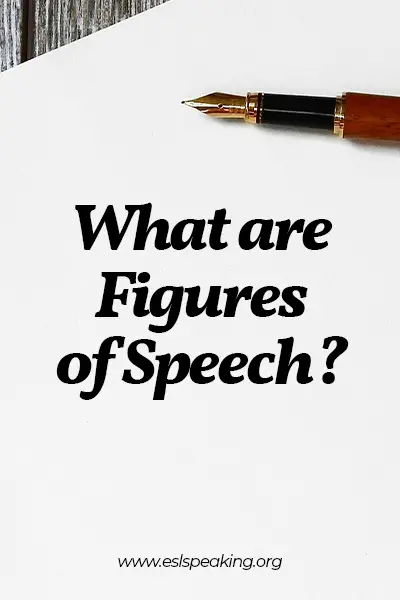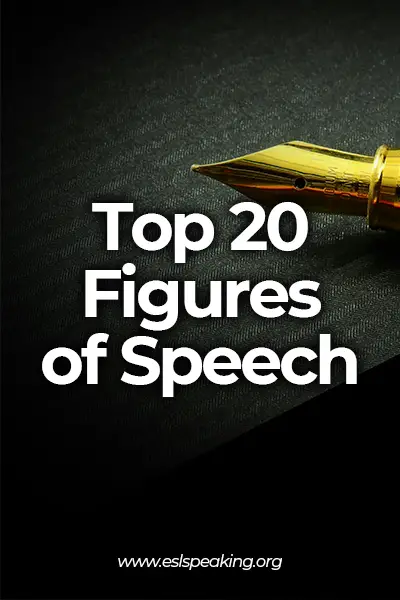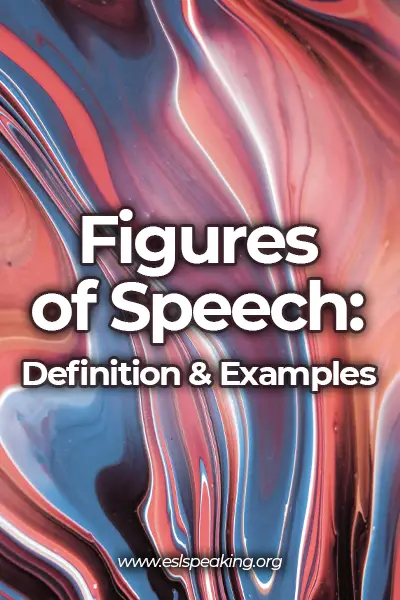As an English learner, you probably would have heard of metaphor, personification, or simile. These are the most common types of figures of speech in English. Figures of speech play a significant role in English speaking and writing. You don’t necessarily use all types of figures of speech on a daily basis, but they act as a powerful tool in writing. In this article, we’ll go over the top 20 figures of speech that you need to know to improve your overall English language skills.

What is a Figure of Speech?
A figure of speech is a way of using language that goes beyond its literal meaning to convey a more vivid or imaginative expression. It involves the use of words or phrases in a non-literal sense to create a specific effect or emphasize a point. Figures of speech add color, creativity, and depth to language, making communication more interesting and engaging.
Importance of Figures of Speech
Figures of speech make language more interesting and expressive. They help convey emotions, create mental images, and emphasize ideas. By using metaphors, similes, and other figures of speech, speakers and writers can make their communication more vivid and memorable. These tools also add creativity to literature, contribute to cultural expressions, and play a role in humor. Overall, figures of speech enhance communication by making it more engaging, impactful, and versatile.
List of 20 Figures of Speech with Definitions and Examples
1. Simile
A simile is a figure of speech that compares two different things using the words “like” or “as” to highlight a shared characteristic. It helps create vivid and imaginative descriptions.
Example: As brave as a lion.
Explanation: Emphasizes the person’s courage by likening it to the well-known bravery of a lion.
2. Metaphor
A metaphor is a figure of speech that implies a comparison between two unrelated things, suggesting that they share common characteristics without using “like” or “as.” It is a way of describing one thing as if it were another to create a deeper understanding or evoke a specific image.
Example: Time is a thief.
Explanation: Time is compared to a thief to convey the idea that it steals moments or experiences.
3. Personification
Personification is a figure of speech in which human attributes or qualities are given to non-human entities or objects. It involves treating something non-human as if it has human-like characteristics.
Example: The wind whispered through the trees.
Explanation: Personifies the wind by attributing the human quality of whispering to it.
4. Hyperbole
A hyperbole is a figure of speech that involves exaggerated statements or claims not meant to be taken literally. It is used to emphasize a point, create emphasis, or add dramatic effect.
Example: I’ve told you a million times to clean your room
Explanation: The exaggeration of a million times emphasizes the speaker’s frustration or annoyance. The person didn’t actually say it a million times.
5. Alliteration
Alliteration is a series of words in a sentence or phrase that share the same initial consonant sound. It is often used to create rhythm, emphasize a particular sound, or make language more memorable.
Example: Sally sells seashells by the seashore
Explanation: The repetition of the “s” sound adds a musical quality to the sentence.
6. Assonance
Assonance is where the repetition of vowel sounds occurs within nearby words in a sentence or phrase. It is used for musicality, emphasis, or to create a specific mood.
Example: Hear the mellow wedding bells
Explanation: The repetition of the long “e” sound enhances the melodic quality of the expression.
7. Irony
Irony is a discrepancy between what is said and what is meant, or between appearances and reality. It often involves a twist or contradiction that may be humorous, thought-provoking, or even tragic. An example of irony is situational irony, where a fire station burns down; this situation is ironic because a place dedicated to preventing fires becomes the victim of one.
8. Oxymoron
An oxymoron combines contradictory or opposing words to create a paradoxical effect. It is used to convey complexity, irony, or a unique perspective.
Example: jumbo shrimp
Explanation: The juxtaposition of “jumbo” and “shrimp” creates a contrasting and somewhat humorous image.
9. Onomatopoeia
Onomatopoeia is a figure of speech where words imitate the natural sounds associated with the objects or actions they refer to. These words are often used to evoke a sensory experience and bring a vivid quality to language.
Example: buzz
Explanation: The word itself imitates the sound of a buzzing bee.
10. Euphemism
A euphemism is a mild or indirect expression used to replace a harsh or blunt phrase that might be considered impolite, offensive, or too direct. It is often employed to soften the impact of sensitive or uncomfortable topics.
Example: Using “passed away” instead of “died” to refer to someone’s death
Explanation: “Passed away” is considered more gentle and considerate than “died.”

11. Cliché
As a figure of speech, a cliché refers to an expression, idea, or phrase that has been so overused that it has lost its originality and impact. It involves using a predictable or stereotyped phrase that may lack creativity.
Example: Saying “quiet as a mouse” to describe silence is a cliché
Explanation: The phrase is often used and has become a common expression.
12. Allusion
An allusion involves referencing a well-known person, place, event, or work of art within a conversation, text, or speech. It allows the speaker or writer to convey complex ideas or emotions by drawing on the associations and meanings attached to the referenced element.
Example: Saying someone has “the Midas touch.”
Explanation: It is an allusion to the mythical King Midas, known for turning everything he touched into gold, suggesting a person’s ability to turn things successful or prosperous.
13. Anaphora
Anaphora is a figure of speech where a word or phrase is repeated at the beginning of successive clauses or sentences. It is used for emphasis, rhythm, and to create a powerful impact.
Example: Martin Luther King Jr.’s “I Have a Dream” speech
Explanation: He repeatedly begins sentences with “I have a dream” to highlight and reinforce his vision for a better future.
14. Chiasmus
Chiasmus is a figure of speech where the order of words or phrases in one clause is reversed in the following clause. This creates a balanced and often symmetrical structure, adding emphasis and style to the expression.
Example: Ask not what your country can do for you, ask what you can do for your country.
Explanation: The order of the terms is reversed in the second part, creating a memorable and impactful rhetorical structure.
15. Litotes
Litotes is a figure of speech that uses double negatives or understatement to emphasize an idea by negating its opposite.
Example: Not bad
Explanation: Conveys that something is good but in a subtle or understated manner.
16. Paradox
A paradox is a statement or situation that appears self-contradictory or absurd, but in reality, it illustrates a deeper truth or logic, often highlighting the complexities and nuances of a concept.
Example: Less is more
Explanation: The apparent contradiction suggests that simplicity or having less can sometimes be more effective or valuable.
17. Epistrophe
Epistrophe is a figure of speech where a word or phrase is repeated at the end of successive clauses or sentences. It is used to create emphasis, rhythmic effect, and a memorable expression.
Example: Abraham Lincoln’s “Gettysburg Address”
Explanation: “…and that government of the people, by the people, for the people…” The repetition of “people” occurs at the end of each phrase for emphasis.
18. Synecdoche
Synecdoche is a figure of speech in which a part of something is used to represent the whole, or vice versa. It involves substituting a specific attribute or component for the entire entity.
Example: All hands on deck
Explanation: This means that everyone (the hands) is needed to help, representing the entire person.
19. Antithesis
Antithesis is a figure of speech that involves the juxtaposition of contrasting ideas or words within parallel grammatical structures. It is used to emphasize the stark contrast between two opposing elements.
Example: “It was the best of times, it was the worst of times” from Charles Dickens’ A Tale of Two Cities
Explanation: The contrasting ideas of “best” and “worst” highlight the dual nature of the time period described.
20. Apostrophe
Apostrophe, as a figure of speech, is when a speaker addresses an absent or imaginary person, a non-living object, or an abstract concept as if it were present and capable of responding. It often involves a strong emotional expression.
Example: Shakespeare’s “Julius Caesar” when Mark Antony says, “O, pardon me, thou bleeding piece of earth,”
Explanation: Addresses the lifeless body of Caesar as if it could hear and respond.

FAQs About Figures of Speech
Here are some of the most frequently asked questions about figures of speech in English.
What are the 12 main figures of speech?
The 12 main figures of speech include simile, metaphor, personification, hyperbole, onomatopoeia, alliteration, assonance, euphemism, oxymoron, allusion, chiasmus, and litotes.
What are the 10 types of figure of speech and their meaning?
The 10 types of figures of speech and their meanings are:
- Simile: Comparing two unlike things using “like” or “as.”
- Metaphor: Implies a resemblance between unrelated things without using “like” or “as.”
- Personification: Giving human characteristics to non-human entities.
- Hyperbole: Exaggerating statements for emphasis or effect.
- Onomatopoeia: Words imitating natural sounds.
- Alliteration: Repetition of initial consonant sounds in nearby words.
- Assonance: Repetition of vowel sounds within nearby words.
- Euphemism: Substituting a milder or indirect expression for a harsh or blunt one.
- Oxymoron: Combining contradictory terms to create a paradoxical effect.
- Allusion: Referencing a well-known person, place, event, or work of art.
What are 5 examples of personification?
Here are 5 examples of personification:
- The sun smiled down on the beach.
- The wind whispered through the trees.
- Time flies when you’re having fun.
- The flowers danced in the breeze.
- The alarm clock screamed at me to wake up.
How many figures of speech are there in total?
According to Professor Rober Diyanni, “rhetoricians have catalogues more than 250 different figures of speech.” However, there are mainly 10-20 figures of speech there are commonly used.
Is my shoes are killing me a hyperbole?
“My shoes are killing me” is hyperbole because it is an exaggerated statement meant to convey extreme discomfort, not to be taken literally.
What are some examples of hyperbole?
Here are 5 examples of hyperbole:
- I have a million things to do.
- It’s raining cats and dogs.
- This suitcase weighs a ton.
- I’m so hungry I could eat a horse.
- The queue at the amusement park is a mile long.
Is idiom a figure of speech?
Yes, an idiom is a type of figure of speech. Idioms are expressions whose meanings cannot be inferred from the literal interpretation of their individual words.
More English Resources
If you want to learn more about the English language, check out the following topics.
- Choose your Own Adventure ESL Writing Activity
- Sequence Words: Meaning and Examples in English
- American English Idioms and Phrases to Learn
- 100 Common English Questions and How to Answer Them
- Parts of Speech Activities ESL | Adverbs, Articles, Nouns, Verbs
Figures of Speech: Join the Conversation
Which figure of speech interests you the most? Choose one and try creating an example yourself. When you’re done, share yours in the comments! We’d love to hear from you.





Leave a Reply